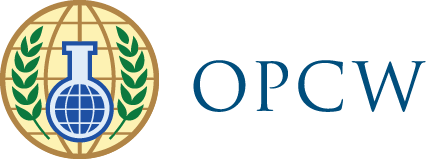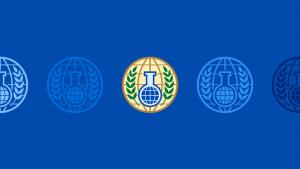The OPCW is responsible for the implementation of the Chemical Weapons Convention (CWC), which prohibits the use, development, production, stockpiling and transfer of chemical weapons.
The Syrian Arab Republic became a State Party to the CWC — and a Member State of the OPCW — in October 2013. As a result of a joint OPCW-UN mission (October 2013 – September 2014) in cooperation with the Syrian government, all of the chemical weapons declared by Syria were removed and verifiably destroyed outside of its territory. However, questions about the completeness of Syria’s declaration remain.
As every other State Party to the Convention, Syria is subject to the following obligations:
-
Never under any circumstances to develop, produce, acquire, stockpile, retain, transfer or use chemical weapons (Article I of the Convention);
-
Submit timely, accurate, complete declarations related to chemical weapons and chemical weapons facilities on its territory (Article III of the Convention);
-
Cooperate with the OPCW in the exercise of all its functions and provide assistance to the Technical Secretariat (Article VII of the Convention).
To ensure Syria’s compliance with its obligations under the Convention, there are currently three different OPCW missions with an active mandate to work on chemical weapons verifications issues: the Declaration Assessment Team (DAT), the OPCW Fact-Finding mission (FFM), and the OPCW Investigation and Identification Team (IIT). All three missions have different mandates. Their findings are based on scientific methods and evidence, and are provided to Member States and other entities (for example, the United Nations Security Council) on a regular basis.
Active OPCW mandates
Declaration Assessment Team (DAT)
The DAT was established in 2014 to engage with relevant Syrian authorities on gaps, inconsistencies, and discrepancies identified by the Technical Secretariat in the Syrian initial declaration of its chemical weapons programme.
OPCW Fact-Finding Mission (FFM)
The FFM was set up in 2014 and investigates whether toxic chemicals have been used as weapons in Syria.
Investigation and Identification Team (IIT)
The IIT was established in 2018 and is responsible for identifying the perpetrators of specific instances of chemical weapons use in Syria.
Previous International Missions and Mechanisms
There were previously two other missions with a mandate to work on chemical weapons issues in Syria – the OPCW-UN Joint Mission and the OPCW-UN Joint Investigative Mechanism (JIM). The mandates of both missions have expired.
OPCW-UN Joint Mission
The OPCW-UN Joint Mission (October 2013 – September 2014) was established to oversee and verify the timely elimination of Syria’s chemical weapons programme in the safest and most secure manner possible, following the country’s accession to the CWC.
OPCW-UN Joint Investigative Mechanism (JIM)
The OPCW-UN Joint Investigative Mechanism (JIM) was established by the UN Security Council to identify the perpetrators of the chemical weapon attacks confirmed by the OPCW Fact-Finding Mission. The JIM presented its reports to the UN Security Council and informed the OPCW of its findings. The JIM’s mandate expired in November 2017.
Background
In April 2021, the Conference of States Parties adopted a Decision to suspend certain rights and privileges of the Syrian Arab Republic under the Convention pursuant to paragraph 2 or Article XII of the Convention. This is the part of the Convention that refers to measures to redress a situation of non-compliance.
The Decision suspends Syria’s rights and privileges under the Convention to:
a) vote in the Conference and the Council;
b) stand for election to the Council;
c) hold any office of the Conference, the Council or any subsidiary organs.
Syria’s rights and privileges will be reinstated by the Conference once the Director-General has reported that Syria has completed all the required measures laid out in the Decision.
Related News
More News- Syria’s caretaker Foreign Minister addresses OPCW’s Executive Council In a landmark visit to OPCW’s Headquarters in The Hague, caretaker Foreign Minister al-Shaibani reaffirmed the commitment of the new Syrian authorities to cooperate with the OPCW to eliminate the chemical weapons programme of the former Syrian regime
- OPCW Director-General visits Syria; meets with Syrian caretaker authorities to discuss next steps in eliminating Syria’s chemical weapons programme OPCW stands ready to support Syria in meeting its obligations under the Chemical Weapons Convention, Director-General Arias says
- OPCW urges Syria to fulfil Chemical Weapons Convention obligations Extraordinary meeting of OPCW Executive Council discussed the current situation in Syria and highlighted significant points regarding the Syrian Chemical Weapons Programme
Progress Reports
Decisions
Reports
Updates
FFM Related
| Document Symbol | Title | Date |
|---|---|---|
| EC‑90/NAT.41 | Russian Federation: Request for Circulation of a Document | 26 April 2019 |
| EC‑88/DG.22/Corr.1 | Opening Statement by the Director-General to the Executive Council at its Eighty-Eighth Session - Corrigendum | 16 July 2018 |
| EC‑88/DG.22 | Opening Statement by the Director-General to the Executive Council at its Eighty-Eighth Session | 10 July 2018 |
| EC‑85/DG.16 | First Inspections at the Barzah and Jamrayah Syrian Scientific Studies and Research Centre Facilities in the Syrian Arab Republic in Accordance with Decision EC-83/DEC.5 (dated 11 November 2016) | 2 June 2017 |
| S/1255/2015*/Add.1 | Future Activities of the Fact-Finding Mission - Addendum | 13 March 2015 |
| S/1255/2015* | Future Activities of the Fact-Finding Mission | 10 March 2015 |
Related Official Series Documents
Correspondence
Declarations Assessment Team (DAT)
| Document Symbol | Title | Date |
|---|---|---|
| EC‑91/DG.23 | Outcome of Consultations with the Syrian Arab Republic Regarding its Chemical Weapons Declaration | 5 July 2019 |
| C‑SS‑4/DEC.3 | Decision: Addressing the Threat from Chemical Weapons Use | 27 June 2018 |
| EC‑83/DEC.5 | Decision: OPCW-United Nations Joint Investigative Mechanism Reports on Chemical Weapons Use in the Syrian Arab Republic | 11 November 2016 |
| EC‑82/DG.18 | Conclusions on the Outcome of Consultations with the Syrian Arab Republic Regarding its Chemical Weapons Declaration | 6 July 2016 |
| EC‑81/DEC.4 | Decision: Report by the Director-General Regarding the Declaration and Related Submissions by the Syrian Arab Republic | 23 March 2016 |
| EC‑M‑33/DEC.1 | Destruction of Syrian Chemical Weapons | 27 September 2013 |
Related
| Document Symbol | Title | Date |
|---|---|---|
| S/2213/2023 | Note by the Technical Secretariat: Accession of the Syrian Arab Republic to the Chemical Weapons Convention: Ten Years On | 27 September 2023 |
| EC‑97/NAT.7 | Syrian Arab Republic: Request for Circulation of a Document at the Ninety-Seventh Session of the Executive Council | 23 June 2021 |
| S/1934/2021 | Note by the Technical Secretariat: Information Provided by the Syrian Arab Republic for Consideration by the Technical Secretariat: Overview of Processing | 10 March 2021 |



